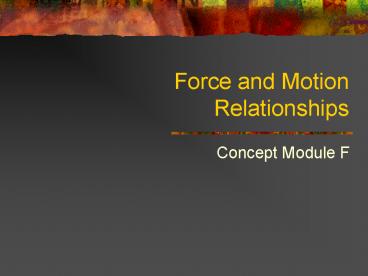Force and Motion Relationships - PowerPoint PPT Presentation
1 / 16
Title:
Force and Motion Relationships
Description:
In projectile situations, as soon as the projectile is released at a specific ... these forces were not present, the projectile would continue to travel in a ... – PowerPoint PPT presentation
Number of Views:22
Avg rating:3.0/5.0
Title: Force and Motion Relationships
1
Force and Motion Relationships
- Concept Module F
2
Linear Speed
- How fast a body is moving.
- Speed distance/time
3
Linear Velocity
- Velocity is a vector quantity because it
possesses both magnitude and direction. - Velocity defines not only the speed at which
something is moving but the direction in which it
is traveling as well. - Vd/t
4
Linear Motion
- Describes a systems distance (d) traveled and
the systems speed and direction (v). - CG is the reference point for segmental motion.
- During cyclic activities a determined point can
act as the reference point
5
Linear Acceleration/Deceleration
- The speeding up, slowing down or changing
direction of a system. - In order for a body/system to experience this
change, it must be acted upon by some net
external force. - The time rate of change in a bodys velocity.
- Achange of velocity/time
6
Linear Acceleration/Deceleration Continued
- A v2-v1/t (v2end velocity and v1 is the
initial velocity)
7
g
- Newtons Law of Universal Gravitation
- The force of attraction between two masses is
directly proportional to the masses of the two
bodies. - Example the greater the masses of the two
bodies, the greater the force of attraction
between them. - gacceleration of a body due to gravity and is
represented as a numerical figure of 9.8 m/sec
8
g Continued
- When a body is free of support it is forced
downward by the gravitational attraction force
equal to the bodys weight. - As it falls it will accelerate at a rate of 9.8
m/sec (during each second it falls) - If a body is thrown upward, it too will
decelerate at a rate of 9.8 m/sec (during each
second it rises)
9
Zero Acceleration/Constant Velocity
- If a net external force acts on a system-the
system will accelerate in the direction of the
applied force. - If no net force is acting on a system the linear
acceleration 0 - If acceleration 0, no change in velocity has
occurred - If a body is moving at a given velocity and
experiences equal opposing forces, there will be
no change in the systems velocity. - When velocity is constant zero acceleration
10
Zero Acceleration-Continued
- Skydiver Example
- Balloon Example
- Feather Example
- Rare occasions in human motion
- Newtons 1st Law a body at rest will stay at
rest until a net external force acts to
accelerate it and a body in motion will stay in
motion at a constant velocity and in the same
direction until a net external force acts to
change it.
11
Variable Velocity
- Average velocity The average of velocity
changes throughout an activity. - Changes in velocity occur during the course of
most human experiences due to the type of
activity, external forces, etc. - Small time intervals are often the focal point
for analyzing movement skills. (acceleration
phases of activity are often most
scrutinized-propulsion, release, follow-through,
etc)
12
Variable Velocity-Continued
- Instantaneous Velocity Used when analyzing the
projection of objects also called release
velocity. - In projectile situations, as soon as the
projectile is released at a specific speed and
direction, its velocity will begin to change due
to gravity and air resistance. If these forces
were not present, the projectile would continue
to travel in a straight line with a constant
speed.
13
Force, Mass and Linear Acceleration Relationship
- Newtons 2nd Law The acceleration of a system
is directly proportional to the net applied force
and inversely proportional to the mass of the
system. - a F/m or F m x a
14
Force, Mass, Acceleration Relationship-Continued
- The greater the force applied to a constant mass,
the greater the acceleration of the mass. - As the mass of an object is increased and the
applied force stays the same, the acceleration of
the object will decrease. - As the mass of an object is increased, more force
must be applied to it to produce a given
acceleration.
15
Acceleration and Deceleration Forces of the Body
- The greater a bodys mass the more friction force
needed to accelerate/decelerate the mass. - Runner Example with ground reaction forces.
16
Centripetal Force and Radial Acceleration
- Same concept as Linear acceleration.
- The greater the mass being rotated, the greater
the centripetal force production to cause radial
acceleration (direction change). Swing example.































